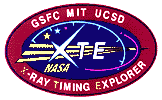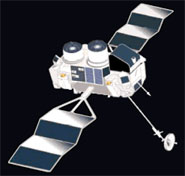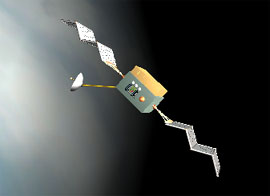Research
Activities
Current research projects in which Group K scientists are involved
include:
The Unconventional Stellar Aspect Satellite
The Unconventional Stellar Aspect (USA) is an X-ray timing experiment that
was launched on
February 23, 1999 on the Advanced Research and Global Observations Satellite (ARGOS). It is designed for scientific research in X-ray timing and time resolved
spectroscopy and also for exploration of application of X-ray sensor technology. Bright
galactic X-ray binaries will be used simultaneously for both scientific and applied
objectives. To find out more about the USA experiment please visit the USA homepage at http://xweb.nrl.navy.mil/www_hertz/usa/usa.html.

Back to Top
The Rossi X-ray Timing Explorer Satellite
Group K is involved in analysis of the guest observer data. The Rossi X-ray
Timing Explorer is a Goddard mission which was launched on December 30th, 1995. RXTE is
designed to facilitate the study of time variability in the emission of X-ray sources with
moderate spectral resolution. Time scales from microseconds to months are covered in an
instantaneous spectral range from 2 to 250 keV. It was designed for a required lifetime of
two years, with a goal of five years. To find out more about RXTE please visit http://heasarc.gsfc.nasa.gov/docs/xte/xte_1st.html.

Back to Top
BATSE
BATSE is one of three of the instruments launched aboard the Compton Gamma-ray
Observatory. One of BATSE's primary objectives is study of the mysterious phenomenon of
gamma-ray bursts - brief flashes of gamma rays which occur at unpredictable locations in
the sky. In 1998, Andrew Lee received his Stanford Ph.
D. in Physics for a study of gamma-ray bursts entitled Properties of Time Profiles of
Gamma-ray Bursts Using Pulse Decomposition Analysis. You can find out more about
BATSE at the CGRO homepage at http://cossc.gsfc.nasa.gov/.

Back to Top
Gamma-ray Large Area Space Telescope
The GLAST Mission is under study for flight in the first decade of the next century.
GLAST is a next generation high-energy gamma-ray observatory designed for making
observations of celestial gamma-ray sources in the energy band extending from 10 MeV to
more than 100 GeV. It follows in the footsteps of the CGRO-EGRET experiment, and is a top
priority mission in the Structure and Evolution of the Universe theme area in the NASA
Office of Space Science. You can find more general information on the GLAST mission at http://www-glast.sonoma.edu.

Back to Top
Group K Tools
Some of Group K's research activities are service-oriented and ongoing. One of
those activities is the maintainance of an IDL users' library containing documents and
procedures useful for the analysis of X-ray timing data.

Click here to Enter
Back to Top |
